How to choose a water heater for an apartment and a country house
If hot water is often turned off in an apartment building, it is worth purchasing a device for its uninterrupted supply. How to choose a water heater for an apartment or your own home, taking into account the needs of your family?
To do this, you need to take into account many characteristics on which the service life of the equipment depends. It must be chosen taking into account the available space in the bathroom or kitchen. In an apartment this issue is especially relevant.
In this article we will outline all the nuances of choosing water heaters, understand the types of heating elements, and the operating principles of various types of equipment.
The content of the article:
Case material as a guideline for choice
The service life of a heating device directly depends on the material from which it is made. If the heating elements and anodes still need to be replaced, then corrosion on the body will completely damage the device beyond repair.
If the mounted heating unit breaks from the fastenings, this will also lead to failure due to the low quality materials used in the manufacture.
There are a variety of metal enclosures available with different types of internal coatings. You can choose an option of acceptable quality for relatively little money, but you should give preference to well-known manufacturers who value their reputation.
In this case, the likelihood of device failure due to poor quality of source materials is minimized.
Enameled coating is a market favorite
Enamel and its variations are the most popular coatings for the body of devices that heat water (mainly storage type). It ideally protects the steel base from contact with water and the formation of rust.
However, enamel without the addition of other components is brittle and can peel off from the walls of the container. Most often, the coating does not withstand excess temperature conditions. In this case, cracks form.
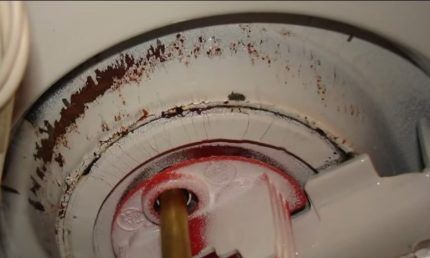
To prevent cracking and destruction of the protective shell with subsequent corrosion of the body, titanium or cobalt is added to the enamel. These metals enhance strength and increase the service life of the water heater.
If the heater body is covered with high-quality enamel protection (especially the joints), then the properties of the steel body will not be inferior to stainless steel coatings.
Super resistant stainless steel
One of the most practical materials for a water heater body is stainless steel. It has a number of key advantages over any enamel coating. The first of these is heat resistance.
If it happens that the boiler is plugged in without first filling it with water, the housing will not be damaged. Only the heating element will burn out, which can be replaced and continued operation of the device.
The second advantage of stainless steel is its resistance to mechanical stress.In case of an accidental impact or fall, the case and its technical contents will not suffer damage. In extreme cases, light dents can be straightened in a workshop.
If the connecting seams are welded using corrosion-resistant metals, as is done by some Scandinavian manufacturers, then the service life will be many times longer than the warranty.
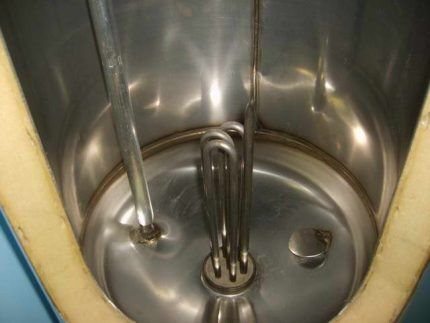
Some manufacturers coat stainless steel with silver plating. This is an advertising ploy based on the bactericidal properties of this non-ferrous metal. The water in the boiler heats up enough to kill pathogenic microflora, so there is no point in overpaying for silver coating.
Innovative glass ceramics and bioglass porcelain
Glass ceramics differs from enamel in that it reduces the thermal conductivity of the container. A water heater treated with this material will not emit heat, which means the water in it will cool slowly. This reduces power consumption. The disadvantage of the coating is its sensitivity to point mechanical effects.
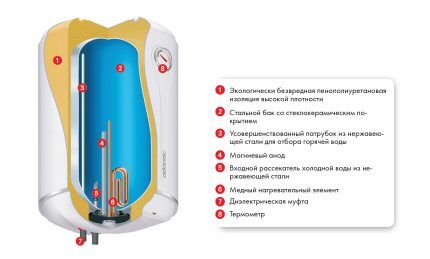
Bioglass ceramics or bioglass porcelain is a rather expensive material that is not used in budget models. Unlike enamel and glass ceramics, it does not contain toxic substances that are harmful to the human body and is completely biologically safe.Does not interact with moisture and is also resistant to temperatures from 60 to 70 degrees Celsius.
Overview of water heating elements
The heating method is an important characteristic of the device. The heating element can be in direct contact with water, or be protected from it by a metal element.
You must choose based on your financial capabilities. Boilers with a non-contact heating element are more expensive than those with contact ones.
Wet heating element
If the water that enters the house has good sanitary and epidemiological indicators and does not contain fine suspended matter from old metal pipes, then you can save money and purchase a water heater with a wet-type heating element.
Additionally, you need to be on the safe side if the water contains a high content of mineral salts (as is often the case in private country houses), and install a filter. The need for a filter is determined simply; if scale often appears in an electric kettle, then the salt content in the water is increased.
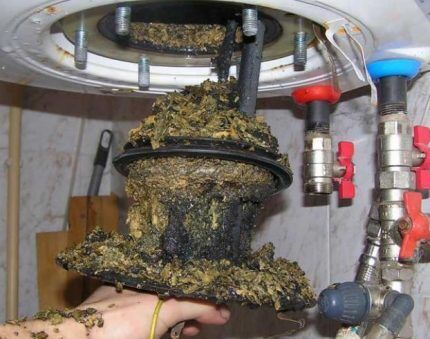
In addition, in the event of such a breakdown, replacing a wet heating element will require additional costs and time. Models from different manufacturers have heating elements that differ in size and power. You will have to wait for the necessary parts, as they are not always in stock.
Dry heating element
If financial resources allow, it is better not to save and buy a boiler with a dry-type water heating element.It is also necessary to choose a unit with a tank made of wear-resistant material, otherwise there will be a risk that the boiler will fail due to depressurization of the housing, and this will inevitably lead to the purchase of a new device (even with a working heating element).
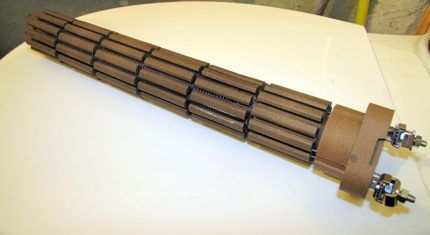
Another advantage is simplicity replacing the heating element. You can do it yourself without resorting to the services of specialists.
The disadvantages include the fact that the use of this element makes the device 15%-20% more expensive, but in the long run it pays off and even allows you to save on repairs.
Heating control system
All models of water heaters are equipped with a sensor that allows you to obtain reliable values of the degree of water heating. If it is noticed that the boiler begins to heat water longer than expected, this will give a signal to replace the heating element.
In addition to the sensor, devices are often equipped with a thermostat. They allow you to control the heating. This is done to save energy.
Simple mechanical thermostat
In budget models, an ordinary switch is installed, which can be made in the form of a round regulator or buttons. With its help, you can change the heating from 60 degrees to 30. It is impossible to set the exact temperature value; it will be observed with an error of several degrees.
As a rule, these mechanical regulators are interchangeable; you can often find an analogue in the event of a breakdown. Their replacement is simple and does not require the help of service specialists.This is where their advantages end.
Automatic thermostat with advanced functions
Such boilers are equipped with additional features, including programming for a specific period of on or off. It is possible to set the required heating temperature with high accuracy.
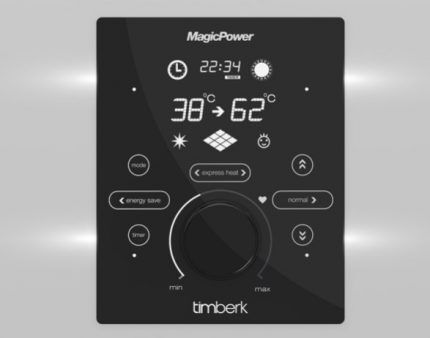
If a company leaves the market, spare parts will be impossible to obtain. A minor breakdown in the electronics may lead to the need to buy a new device. It is worth giving preference to trusted manufacturers.
Operating principle and performance comparison
In addition to the material of the housing, heating element and thermostat, there are significant differences in the design and operating principle of water heaters. They can use gas or electricity for heating.
It is worth considering gas water heaters They are more expensive, they are cheaper to operate, but cannot be used in an apartment. Their purpose is to provide hot water to private country houses. Electric ones are correspondingly cheaper, but they are expensive. They can be used in an apartment. Now more details about everyone.
Electric instantaneous water heating devices
The principle of their operation is to heat water, which flows through the heating element continuously when the tap is open. In the design of these models, the material that was used to make the container does not play a leading role.
Their advantage is the supply of freshly prepared hot water, for the reason that there is no need to wait a long time for it to heat up.You can receive unlimited volume.
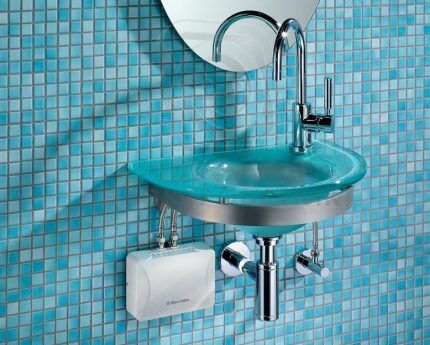
Another disadvantage of the device electric water heaters is heating only for one water supply point. The one to which it is directly connected. If the device is connected to a shower or bathtub, then hot water will be supplied only to them.
Using two instantaneous water heaters is extremely unprofitable in terms of electricity bills. This option is suitable only for apartments where there are periodic seasonal interruptions in hot water supply.
Storage electric water heaters
The principle of operation of boilers is to heat a certain amount of water and maintain its temperature.The maximum energy consumption is fixed when filled with cold water, because the body of the water heater has a thermos design.
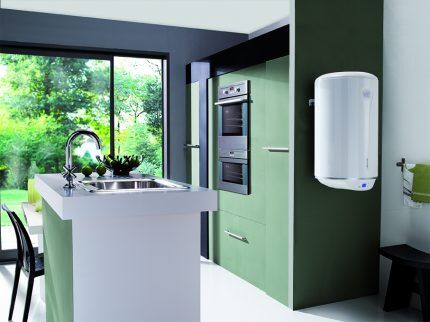
In addition to their shape, boilers are divided into horizontally oriented and vertically oriented. This variety is due to the popularity of these water heaters, which can be placed in any room, kitchen, bathroom or toilet. The shape is determined solely by the available space.
An essential characteristic of the device is the volume of the tank. The most popular water heaters with displacement are:
- 30 cu. liters;
- 50 cu. liters;
- 80 cu. liters;
- 100 cu. liters;
The size is determined by the number of people living in the house or apartment. If the number of people is higher than that for which the boiler is designed, you will have to wait a long time until the water heats up to an acceptable temperature.
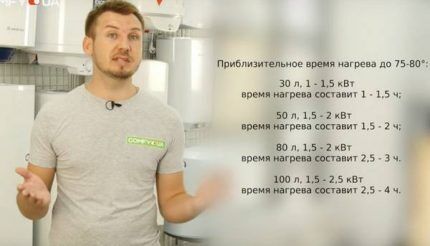
When choosing a mounted boiler, it is important to make sure that the mounting method is reliable. Fastening elements must be made of high quality steel. This is necessary for safe fixation on a load-bearing wall.
In some cases, it is better to choose a floor-mounted water heater if the partitions cannot support the weight of the device filled with water. A floor-standing boiler is safer, so families with children are better off choosing similar models.
Read more about choosing storage water heaters Further.
Gas instantaneous water heaters
If a country house is heated with gas, then it is better to opt for gas water heaters, as they are cheaper to operate. The most popular type of gas water heater is instantaneous. It has all the benefits of its electrical counterpart, but without the significant wiring stress on the wiring.
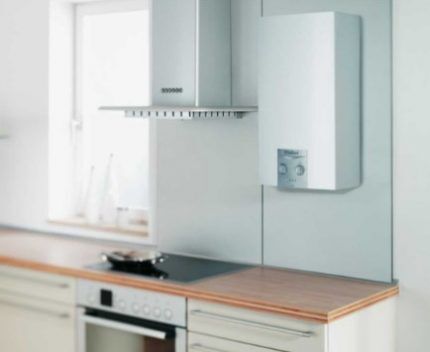
Unlike an electric water heater, several hot water distribution points can be connected to a gas unit.
The disadvantages of this type of water heaters include the need to install a ventilation pipe. The heating principle is based on the combustion of natural gas, which is impossible in the absence of oxygen supply and removal of combustion products.
Geysers differ in the ignition method. Since the equipment is a source of increased danger, it has a built-in function for automatically shutting off the gas supply if backdraft occurs in the chimney and the wick goes out. There are geysers that require a spark to be supplied by pressing a button, and there are models where this happens automatically.
We also recommend that you familiarize yourself with the best models of instantaneous gas heaters. More details - go to link.
Double-circuit gas boiler
Which water heater should I choose for installation in a country house if it does not yet have heating, but has a gas supply? In this case, the best solution would be a double-circuit gas boiler.
This is a complex device that solves two problems in a country house at once:
- Living space heating.
- Heating water for domestic needs.
This is a great way to save money, because buying a double-circuit boiler is cheaper than the total cost of a boiler with a solid fuel boiler.

Boilers can be wall-mounted and floor-standing, it depends on their dimensions. In country houses with a large area, it is necessary to install floor-mounted ones, as they can completely solve the problem of heating spacious rooms.
Conclusions and useful video on the topic
The video describes the general principle of selecting a boiler:
Practical tips for choosing a water heater:
Video on how to choose a gas instantaneous water heater:
You need to choose a water heater based on your personal needs. If gas is supplied to the apartment, then it is better to purchase geyser. It will completely satisfy the need for hot water in uninterrupted mode, unlike electric analogues.
If there is no gas in a private house or apartment, you should opt for electric storage water heaters, as they are more productive than instantaneous ones.
What kind of heater do you use? Please tell us in the comments which device you chose, are you satisfied with its performance? You can also ask questions about the topic of the article, and we will try to give a very clear answer.




I have a boiler with a dry water heating element at home. When I bought it, I didn’t yet know that this was a big plus. After ten years of uninterrupted operation, I have no complaints about it. The heating element burned out, I replaced it myself without any problems. After all, for this there is no need to drain the water and get inside the tank. The neighbor has a boiler with a wet water heating element. He had to tinker to replace the burnt out element. And I drained the water and took out two buckets of scum from the tank.I advise everyone when buying a boiler, buy the one with dry heating elements.
As soon as we received the keys to the new apartment, we were puzzled by the issue of the water heater. We know from experience that in the first year after putting a house into operation, hot water supply shutdowns happen all the time. But our situation is non-standard - there are two water supplies to the apartment. Moreover, they are spaced at a distance of about two meters: in the bathroom and in the kitchen.
It turns out that you will have to install two heaters. We’ve decided on the bathroom - we’ll take an electric storage tank of 80 or 100 liters. But we are still arguing with the kitchen - my wife says that we need a small storage tank, 15 liters, but I think that we can get by with an electric flow one... We are a family of 3 people, the water consumption in the kitchen is not very high. But my wife has a prejudice against flow-through ones... I would like to hear the opinion of experienced people.
Usually in the kitchen, on the contrary, people do not have enough space, either for a dishwasher or for something else. Even a small storage water heater has a tank for which you need to find a place. You will have to occupy some kind of cabinet, or a wall on which the cabinet could hang. My opinion is that a flow-through heater is much more practical for a kitchen. The only thing is that its connection is more complicated - you need to pull a separate cable. If you are not comfortable with electricians, it is better to call a professional.
Hello. You yourself said that you have regular interruptions in your hot water supply. A storage tank in the kitchen would allow your wife to start cleaning and washing dishes at a comfortable temperature for her hands at any time convenient for her.
The house has a boiler with dry heating elements.During its service life, which is about 4-5 years, there were no problems with it. But at the dacha there is a boiler with a wet water heating element, and when the heating element burned out, they wanted to replace it. But there was a lot of trouble. As a result, we decided to buy the same boiler for our dacha that works at home. It turns out that units with dry heating elements are the most practical and problem-free.